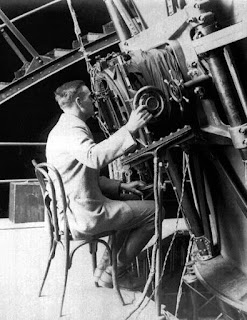Blog 3 - Mt Wilson (Tram Dang)
For our class, we are to go to Mt. Wilson and take astrophotography. I didn’t know much about this place, nor did I understand the significance that Mt. Wilson had on astronomy and science. All because of one person love for stars, we learned that their was an undiscovered new frontier to explore, space.
So what exactly is Mt. Wilson? Mount Wilson is located within the San Gabriel Mountains National Monument and Angeles National Forest in Los Angeles County, California. Established in 1904 by George Ellery Hale, Mount Wilson Observatory today continues to utilize a wide array of solar telescopes, large reflectors, and experimental optical interferometers. In 1918, the largest telescope in the world for 30 years was the Hooker Reflector with a mirror 100 inches in diameter. Its previous successor, who was the largest of its type at the time was the 60-inch reflector, completed in 1908.

That made me curious, why exactly did Hale decide to build the observatory? Hale brought the Snow Solar Telescope from Yerkes Observator, Wisconsin to the sunshine state of Mount Wilson, California to continue his studies of the Sun. He put such importance on studying the Sun, that it was called the Mount Wilson Solar Observatory for the first decade and a half. A major milestone for Mt. Wilson was the construction of the 100 inch telescope, also known as the Hooker Telescope in 1917. It continued to be the largest until it was beat out by the 200 inch Hale Telescope. In 1919, soon after the largest telescope in the world, the 100-inch, went into service photographing the stars and nebulae, the word “Solar” was drop.
It wasn’t until Edwin Hubble used the 100-inch to make two discoveries that fundamentally changed our definition of the universe. First, he realized that some faint, fuzzy objects were in fact, galaxies outside our own Milky Way. Then Hubble recognized that many of these galaxies were speeding away from us, indicating that the universe is expanding. This telescope leads directly to our current understanding of our origins, the Big Bang model.
I think it is so fascinating that all this happen because one person was determined to research the stars, aka the Sun. And in doing so, change the way we understood space. Hubble notable discovery in the 1920s help showed that these “spiral nebulas” were within reach of the Milky Way when in reality the Andromeda Galaxy is a galaxy in its own right.
So what exactly is Mt. Wilson? Mount Wilson is located within the San Gabriel Mountains National Monument and Angeles National Forest in Los Angeles County, California. Established in 1904 by George Ellery Hale, Mount Wilson Observatory today continues to utilize a wide array of solar telescopes, large reflectors, and experimental optical interferometers. In 1918, the largest telescope in the world for 30 years was the Hooker Reflector with a mirror 100 inches in diameter. Its previous successor, who was the largest of its type at the time was the 60-inch reflector, completed in 1908.

That made me curious, why exactly did Hale decide to build the observatory? Hale brought the Snow Solar Telescope from Yerkes Observator, Wisconsin to the sunshine state of Mount Wilson, California to continue his studies of the Sun. He put such importance on studying the Sun, that it was called the Mount Wilson Solar Observatory for the first decade and a half. A major milestone for Mt. Wilson was the construction of the 100 inch telescope, also known as the Hooker Telescope in 1917. It continued to be the largest until it was beat out by the 200 inch Hale Telescope. In 1919, soon after the largest telescope in the world, the 100-inch, went into service photographing the stars and nebulae, the word “Solar” was drop.
It wasn’t until Edwin Hubble used the 100-inch to make two discoveries that fundamentally changed our definition of the universe. First, he realized that some faint, fuzzy objects were in fact, galaxies outside our own Milky Way. Then Hubble recognized that many of these galaxies were speeding away from us, indicating that the universe is expanding. This telescope leads directly to our current understanding of our origins, the Big Bang model.
I think it is so fascinating that all this happen because one person was determined to research the stars, aka the Sun. And in doing so, change the way we understood space. Hubble notable discovery in the 1920s help showed that these “spiral nebulas” were within reach of the Milky Way when in reality the Andromeda Galaxy is a galaxy in its own right.






Comments
Post a Comment